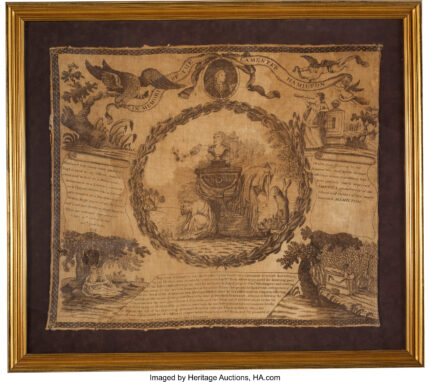An exceedingly rare cotton printed scarf mourning the death of Alexander Hamilton in 1804 will be coming up for auction on May 15th. The scarf is unusually large – 24″ x 20 1/2″ framed to 30 1/2″ x 27″ — and features two portraits of the Founding Father, one in portrait miniature style at the top in his Revolutionary War uniform, and one marble bust in Roman style in the central roundel. The bust is perched atop his tomb (a fantasy version, not his actual tomb) where women weep for the fallen hero. To their left is a small hut with palm trees, symbolizing Hamilton’s birth and childhood in Nevis. To the right is a tree with a cut limb, symbolizing his life cut short.
The portrait miniature hangs from the center of a ribbon held by an eagle on the left and cherubs on the right. Written on the banner is “IN MEMORY OF THE LAMENTED HAMILTON.” In the bottom left is a women with three children sitting under a tree, likely a representation of his wife, Elizabeth Schuyler Hamilton, and family, as the panegyric extolls him as “honourably united in marriage” and laments that “he has left behind him a numerous family to deplore the loss of his protecting arm and directive talents.” In the bottom right, a Black woman mourns at an effigied tomb or bier.
Among the text on the scarf is an encomium (middle left) that studiously avoids the words “duel,” “Aaron” or “Burr” even as it praises his life and recounts its loss.
Endowed with many noble qualities, high in rank as an Officer; enlightened and ardent as a Statesman; preeminent as a Lawyer; rever’d as a Citizen; beloved as a friend; affectionate as a Husband and Father. To the regret of all the great and good, this distinguished Character fell, in an unhappy rencounter, July 11th, 1804; in the 48th year of his AGE.
On the right side is an appeal to legislators to take action against the deadly practice of dueling. Again, the word “duel” does not appear.
Health and Honour to the Senator who shall devise the most effectual means of abolishing that fatal practice which deprived AMERICA prematurely of the talents and virtues of her much lamented HAMILTON!
The scarf has intersecting diagonal lines of stitching that indicate it was once incorporated into a quilt or bedspread. That only adds to its character as the sewing is discrete and does not interfere with the print which is in excellent condition. The only other known example of this scarf, now part of the collection of the Hamilton Grange National Memorial in Manhattan, has no stitching, but it has suffered significant fading and staining.
The pre-sale estimate is $20,000, but Hamilton memorabilia is insanely desirable due to the explosion of interest in the wake of the musical about his life. The Alexander Hamilton powder horn which bears his name and family iconography but is otherwise entirely devoid of any proven connection to the man himself, sold at auction in January 2016 for $115,620, including buyer’s premium.
I can’t let mention of the Hamilton Grange National Memorial pass without paying homage to the amazing feat of conservatorial skill that has saved and revitalized it. When Alexander Hamilton had his handsome Federal-style home built in 1802, it was on 32 bucolic acres in upper Manhattan. They didn’t remain bucolic, needless to say, and in 1889 the house was slated for demolition because it jutted into the street and was in the way of the development of the Manhattan’s street grid. Its neighbor, the Episcopal Church of St. Luke in the Fields bought the house and moved it two blocks away where it no longer impeded the grid.
It became a museum in 1933 and was designated a National Historic Landmark in 1960, but, hemmed in by an apartment building on one side and St. Luke’s on the other, many features of the home were obscured and it was in dire need of major restoration. So they moved it again. They jacked the whole house up, building Jenga-like wood block cribbing underneath it as it rose to sustain its weight. On June 7th, 2008, the Grange was moved at a snail’s pace one block east and one block south to its new location on St. Nicholas Park where it was once again in bucolic surroundings.
It was a much-covered event and I watched it in real time, but the blog was in its dormant phase before I would resurrect it in December of that year, so there was no post about the great move of the only house Alexander Hamilton ever owned. Now I right that wrong.
Here is a time-lapse video of Hamilton Grange 30 feet in the air being moved from its tight quarters between the apartments and church onto the street:
The six-hour move in 39 seconds:
Its installation on new foundations at St. Nicholas Park:
